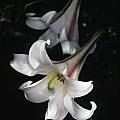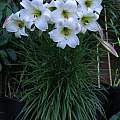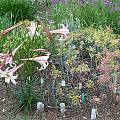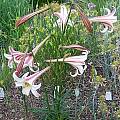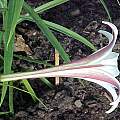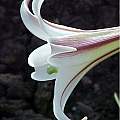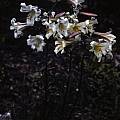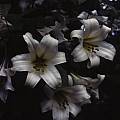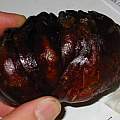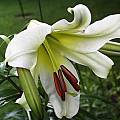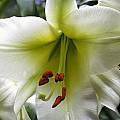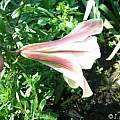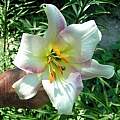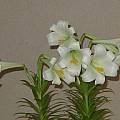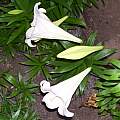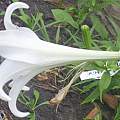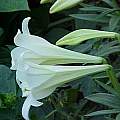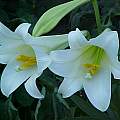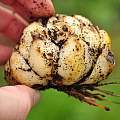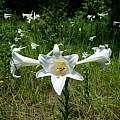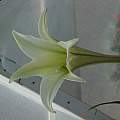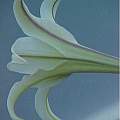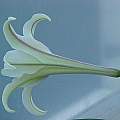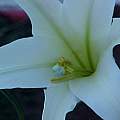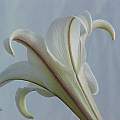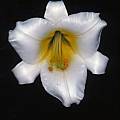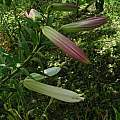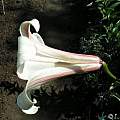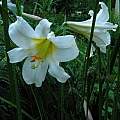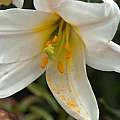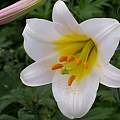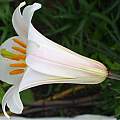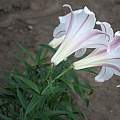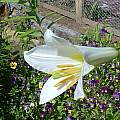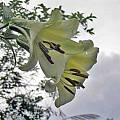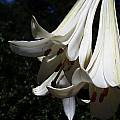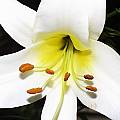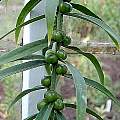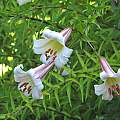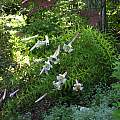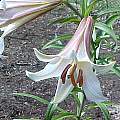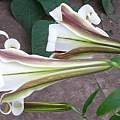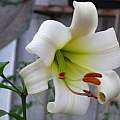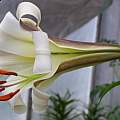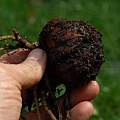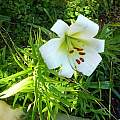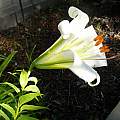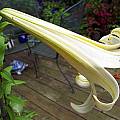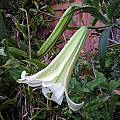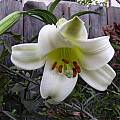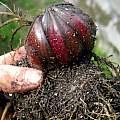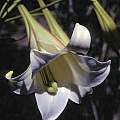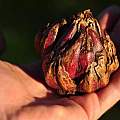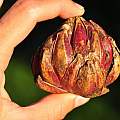Lilium is a large genus in the Liliaceae family. Information and pictures of species on the PBS wiki are found on section pages. This wiki page is for the Trumpet Section. Other sections and hybrids are linked below.
American Section a-m - American Section n-z - Asiatic Section a-c - Asiatic Section d-k - Asiatic Section l-o - Asiatic Section p-z - Candidum Section - Dauricum Section - Martagon Section - Oriental Section - Lilium Hybrids - Lilium index
Lilium formosanum A.Wallace is native to Taiwan. It has naturalized in several countries in Africa, Brazil, Louisiana, Florida, Japan, and New Zealand. It is considered a weed in parts of Australia. Leaves are linear or narrowly lanceolate and the white, fragrant flowers tinged purple-red abaxially are funnelform, with a slender tube. Flowers are solitary or sometimes several in a subumbel. In its home country some of the flowers at low elevations do not have the colorful bands and are all white. It flowers quickly from seed in one to two years, but has a reputation of being short lived for some. Height range: 1-2+ m (3-6-7 ft). The first photo was taken by Ron Parsons of plants in cultivation at the Strybing Arboretum, Golden Gate Park, San Francisco, CA. The second photo by David Pilling shows brown pollen whereas others have yellow pollen. The next three photos from Mary Sue Ittner illustrate ones grown from seed that are all white. The last photo from Christine Doud shows many flowering in her Santa Barbara garden.
Lilium formosanum var. pricei Stoker is a dwarf form (no longer recognized as deserving variety status in 2022) of the much taller Formosa Lily. The taller 'type' species is sometimes considered weedy because it seeds about too readily. This short variety grows 12"-18" (30-45 cm) tall, is reliably hardy even in northern New England, but seems to be short-lived, lasting 2-3 years then dying out, but typically a few seedlings show up. The first two photos by Mark McDonough are two views showing a rogue seedling that got into his bed of Allium flavum ssp. tauricum color forms. The flowers are richly colored on the back, pristine white within, and powerfully sweet scented. Photos three and four were taken by Darm Crook.
Lilium leucanthum (Baker) Baker is from Sichuan China. Height: to about 4 ft. Photos 1-2 were taken by Ron Parsons of plants growing in the UC Botanical Garden. Photo 3 of a bulb by Pontus Wallstén.
Lilium leucanthum var. centifolium (Stapf ex Elwes) is from W. Gansu, China and can grow to 10 feet tall. Photos by Arnold Trachtenberg of plants he grows in New Jersey.
Lilium 'Black Dragon' is a strain derived from Lilium leucanthum var. centifolium. The flowers have rose purple colouring on the outer of the tepals. No hybridisation was involved. The name 'Black Magic' is also used. Height: 5-8 ft. Photos Janos Agoston.
Lilium longiflorum Thunb. is the ever popular "Easter lily" which has been highly hybridized. The species is native to Japan; it can survive zone 1 winters out doors but if left in those conditions it will deteriorate and then disappear after the third summer. When grown in conditions to its liking, it is a robust lily growing up to 90 cm (3 feet) tall and producing clones that will flower the same year they were produced. Although related to Lilium formosanum and Lilium philippinense, it will accept a cool forced dormant period after which it will grow as vigorously as it always has. The florets grow in an umbel inflorescence and are white with a yellow throat and nicely scented. The first photo is one that was set behind the apple tree several years ago and forgotten. There are three stalks and nine flowers all open at the same time. It was grown in Long Beach, CA by Doug Westfall. The second photo of this species was taken by Janos Agoston. Photos three to six were submitted by Darm Crook.
Photo of a bulb by Pontus Wallstén.
Lilium philippinense Baker is one of the most southern based naturally occurring species; it is from the Philippines. It grows up to 90 cm (3 feet) tall; the florets are trumpet form, nicely flared and scented, with a green throat and have a green to brown reverse. It takes 8 to 10 months from seed to first flower. It requires no dormant period and will not survive a forced dormancy period. Like Lilium formosanum it will produce offset clones and grow continuously year round. It is not cold hardy. This is said to be the lily that grows in the most tropical climate, however Lilium wallichianum var. neilgherrense (Wight) H.Hara grows further south, in the Himalayas. Photos from iNaturalist were taken by Eric Keith and shared under a CC BY-NC license.
The five photos below were submitted by Darm Crook.
Lilium regale E.H.Wilson is native to Sichuan, China. This trumpet lilium will grow up to 120 cm (4 feet) tall, bearing usually up to 5 but once in a while as many as 8 sweetly scented florets in an umbel inflorescence. It is a reasonably early flowering trumpet, flowering in late July early August in a zone one environment. As such it is suited to areas with a short growing season. The first photo is of a plant in cultivation at the UC Botanical Garden by Ron Parsons. The next three photos were taken by Janos Agoston. The last one shows variety 'Album' which has pure white flowers. The photo of buds contrasts those of 'Album' with the species. Lilium regale produces a lot of seed and exhibits apomixis. Seedlings are robust, and this is a good first lily to grow from seed. Seeds sown in year N produce flowers in year N+2.
Photos below with the last one being L. regale variety 'Album' posted by Darm Crook
The video below was taken on a perfect summer afternoon, 3 pm on the 27th July 2013 by David Pilling with bees pollinating Lilium regale.
Lilium sargentiae E.H.Wilson grows to 1.5 metres tall, with funnel-shaped, fragrant flowers. This location is further southwest than those normally cited, which are in Sichuan. The first photo, by David Victor, was taken near the Liang Jang (Mekong) river, Yunnan, China. Photos two and three by Arnold Trachtenberg, are of a bulb from a Chinese grower, Chen Yi. Photo four is by John Lykkegaard Johansen and shows bulbils. Photos 5-6 were taken by Nhu Nguyen from the UC Botanical Garden.
Photos 1-4 below submitted by Darm Crook. Photo 5 of a bulb by Pontus Wallstén.
Photos below from Cynthia Mueller were originally on the mystery bulbs page. Cynthia wrote this: "They have lasted well in the heat and relatively dry flower beds at my home here in Central Texas. The large blooms are white, the plant stalks are about three feet high. There are just now many richly green colored axillary bulbils, most with two or three 'toothy' points on top." Bulbs were purchased from Yucca Do Nursery as Lilium brownii, but later they realized that was probably not the correct name and sources don't list that species as having bulbils. The source now believes it to be this species. Cynthia is growing it with erratic summer water, slushy winter soil, highly alkaline, dry and hard packed soil, and city water loaded with salts. She writes it has no pests and is a great choice for Central Texas.
Lilium sulphureum Baker ex Hook.f. is a late blooming trumpet lily having a soft yellow glow from within. Height: to about 8 ft. The first photo by Jim McKenney is of a plant grown by Debby Sheuchenko in central Virginia from material received from Chen Yi. Note the long flower. It came into bloom the first week of August and had abundant stem bulbils. Here in the middle Atlantic states of the US, other trumpet lilies typically bloom from the last week of June through the first two weeks of July. Photos 2-3, taken September 2004 by Lee Poulsen, have greener flowers than Jim's plant. Photo 4 of a bulb by Pontus Wallstén.
Lilium wallichianum Schult. & Schult.f. is a white species from the Himalayan region (India, Nepal, Bhutan, Sikkim) where it is found on limestone slopes in open coniferous forests. Height: to about 6 ft. Photo 1 by Ron Parsons. Photo 2-4 of bulbs by Pontus Wallstén, who comments that when bulbs are young, they have more of a whitish yellow colour, and when older, or when they have been out of the ground for a while, they go more purple pink, like some oriental hybrids.
American Section a-m - American Section n-z - Asiatic Section a-c - Asiatic Section d-k - Asiatic Section l-o - Asiatic Section p-z - Candidum Section - Dauricum Section - Martagon Section - Oriental Section - Lilium Hybrids - Lilium index
